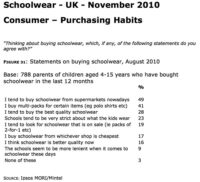 The schoolwear market has been gradually changing as a result of the rising influence of the main supermarket chains, which has led to the price of school uniform garments falling to an all-time low over the last few years. Aggressive price wars between supermarkets have driven the price of school clothing down and meant that other key players in the sector such as high street retailers, department stores and specialist retailers, have struggled to compete.
The schoolwear market has been gradually changing as a result of the rising influence of the main supermarket chains, which has led to the price of school uniform garments falling to an all-time low over the last few years. Aggressive price wars between supermarkets have driven the price of school clothing down and meant that other key players in the sector such as high street retailers, department stores and specialist retailers, have struggled to compete.
Valued at £956 million, the schoolwear market has had a tough few years, falling by 11% since 2007 as the sector has suffered from price deflation. However, sales value has not fallen as drastically as feared, as the fall in the price of uniforms has been countered by more secondary schools introducing stricter uniform policies.
There was a decline in the overall number of schools and the number of pupils in the UK between 2003 and 2008, with a 3.6% fall in schools and a 2% drop in pupil numbers. The decline in the number of primary school pupils is in line with the dip in the birth rate that has worked its way through the primary sector and will impact secondary schools over the next few years.
Over the next five years, the market is forecast to grow by 19% to £1.14 billion in 2015 as rising cotton prices, higher prices charged by suppliers and currency issues force retailers to pass these cost increases onto consumers.
The launch of the first wave of new-style academies has the potential to drive schoolwear sales as many of these institutions have introduced stricter uniform policies, with pupils required to dress more smartly.
The supermarket chains have rapidly expanded their share of the childrenswear market, including schoolwear, as they have been at the forefront of aggressively cutting the price of school uniform. They are currently estimated have around 40% of the total schoolwear market.
Specialist schoolwear shops have lost market share as they struggle to compete with the prices offered by supermarkets and multiple high street retailers.
According to exclusive research, parents with primary school-age children (ie under-10s) are most inclined to buy schoolwear from whichever shop is cheapest.
Secondary school parents, on the other hand, are more likely than those with primary school children to buy the best quality schoolwear. They also show a tendency to spend more on items that will last longer.
Three in ten (29%) parents agree that not enough retailers stock schoolwear all year round.
Secondary school-aged children are very interested in being fashionable and several retailers have responded to this demand, with Tesco launching a mini-skirt as part of its school uniform range and M&S offering a fashion-led schoolwear line.




Comments are closed.